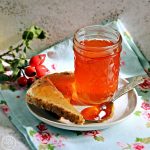How to Make Rosehip & Apple Jelly
Rosehip & Apple Jelly has a beautiful and unique sweet flavour that tastes utterly divine. It’s a flavour that you might expect to find in a sweet shop.
Servings 6 240 ml jars
Equipment
- 1 Digital scales
- 1 Preserving pan or similar sized pan
- 1 Sharp paring knife
- 1 Chopping Board
- 1 ladle
- 1 long wooden spoon
- 1 Large metal spoon
- 1 Glass or ceramic bowl
- 1 Jelly bag and stand (or sieve/colander lined with muslin, cheesecloth or tights).
- 1 jam funnel
- 1 7 x 240 ml jam jars & lids (or equivalent)
Ingredients
- 1 kilogram dessert apples washed, quartered and cut into chunks, don’t peel or core but remove stems.
- 500 grams prepared wild rosehips halved (stems and loose leafy bits pulled off and washed thoroughly)
- 1 unwaxed lemon sliced
- 1.1 kilograms granulated sugar warmed – see notes (approximately, see method for calculation)
- 1.8 litres cold water
Instructions
- Before you start, place 2 – 3 saucers in the freezer and sterilise jars (see notes).
- Pour 1.8 litres of water into a preserving pan and add the lemon slices, chunks of apple as you prepare them (to prevent browning) and the halved rosehips.
- Bring to a boil, then lower the heat to a simmer until fruit is cooked (use a potato masher to break up the apples as they soften). This will take up to 30 minutes.
- Once cooked, allow pulpy mixture to rest for 10 minutes then ladle into a jelly bag (or whatever you’re using).
- Leave the mixture to strain overnight (covering with a clean tea towel).
- The next day, measure the amount of fruit juice produced and calculate the amount of sugar you will need. You’ll need to add 450 grams of sugar for every 575 millilitres of fruit juice. (Just ask Google for 78% of the amount of fruit juice you have and that’s how much sugar in grams you need). I had 1.415 litres of juice so needed 1.1 kilograms of sugar.
- Pour juice and sugar into cleaned preserving pan and stir until dissolved over a low heat (do not allow to simmer or you’ll get gritty jelly).
- Once sugar has dissolved (no crunching sounds when stirring), bring mixture to a rolling boil, stirring constantly, until setting point is reached. This was around 19 minutes for me. You can use the drip test to gauge when the pan is ready to come off the boil (see copy above). You can also use a digital or sugar thermometer which should reach 105°C (but I found setting point actually went to 106°C or more).
- Test for set. Remove pan from heat and pour a few drops of jelly on a chilled saucer and place in fridge for 30 seconds. Run your finger through the jelly and if it wrinkles, it’s ready. If not, place back on a rolling boil for another minute or 2 and keep testing until jelly passes the test.
- Move any scum to one side of the pan and skim off with a large metal spoon.
- Then pot up into hot sterilised jars using a ladle and jam funnel (if you have one). Screw lids on immediately.
- Makes just over 6 small jars.
- Once cool store in a cool, dry, dark place.
Video
Notes
Before you start: Sterilise 7 x 240 ml (8 oz) jars and lids by washing thoroughly in hot soapy water (or take straight from dishwasher), fill jars with boiling water, empty and place on a baking tray. Bake in a preheated oven at 140°C for 20 mins and keep the jars there until ready to pot up. Place lids in a bowl and pour over boiling water, use tongs to lift out and drain on a clean tea towel or draining rack.
Clean jelly bag, muslin, cheesecloth or unworn tights should be sterilised by pouring hot water onto them in a bowl.
Whilst jars are warming spread sugar out on a baking tray and warm through for about 15 minutes.
Clean jelly bag, muslin, cheesecloth or unworn tights should be sterilised by pouring hot water onto them in a bowl.
Whilst jars are warming spread sugar out on a baking tray and warm through for about 15 minutes.
